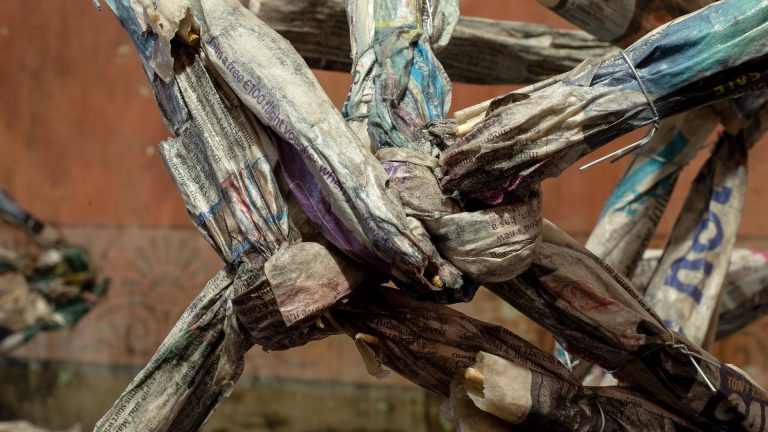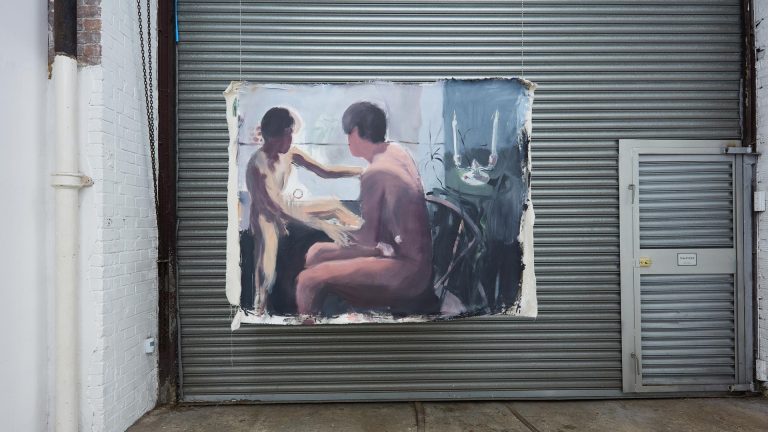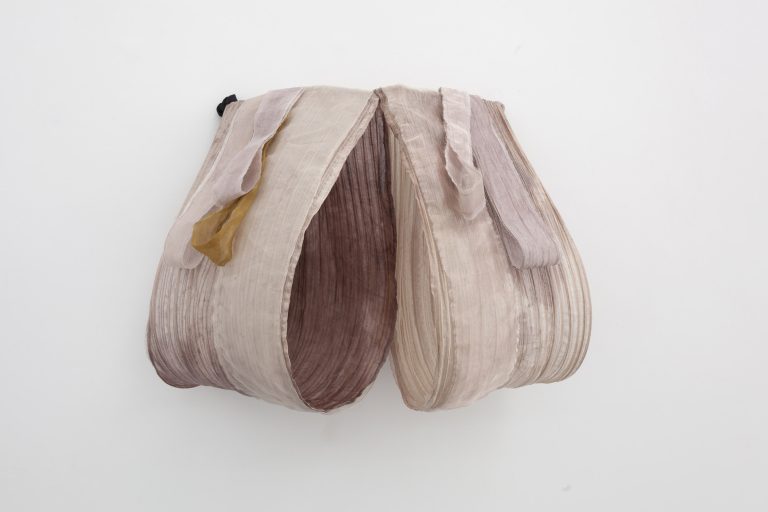Artist: Motoko Ishibashi
Exhibition title: Guru Den
Venue: Bosse & Baum, London, UK
Date: April 25 – May 21, 2017
Photography: all images copyright and courtesy of the artist and Bosse & Baum, London
Motoko Ishibashi started the Guru Den paintings by looking at her digital scrapbook. Whenever she is browsing online and finds an appealing image, she saves it for later use like a newspaper clipping. In this exhibition, these varied sources have materialised into a large-scale canvas with its eclectic cast comprised entirely of the pop star Madonna, and an accompanying series of four beguiling ‘erotic landscapes’.
With A Certain Sacrifice, the Madonna painting that forms the centrepiece of the show, Ishibashi was clear from the beginning that “more was better”. Its precursor was a series of hanging scroll paintings that brought together images of women gathered from the local culture in Northeast Japan where she completed a residency in the winter months of 2016. From here, Ishibashi turned her gaze to a woman who has played a key role in popular Western culture for the last thirty years. Madonna Louise Ciccone – the “Queen of Pop” – has appeared as actress, pop star and public figure, and the painting in Guru Den is a collection of representations of this ‘archetypal’ woman.
This is a provocative painting that defies the visitor to see it as a ‘good’ work of art. Rather than work with ‘actual’ likenesses using photographs, she sourced these imperfectly drawn figures from online fan communities. In opting to replicate these portraits exactly, she has eschewed the use of tracings or projector technology, relying on her precision as a painter to understand the awkwardness of the images ‘from within’.
The painting grates because we are not accustomed to seeing such haphazard characters collected together in the context of an art gallery. Ishibashi follows in the footsteps of the twentieth-century masters of Pop Art: A Certain Sacrifice lies somewhere between Andy Warhol’s Marilyn and Jackie and Roy Lichtenstein’s iconic femmes fatales. In her faithful reproduction of found images on canvas, Ishibashi’s pop aesthetic is tuned not to consumer goods and advertising, but rather to the adoration – perhaps even obsession – at the heart of online fan culture.
The artist plays with this devotional aspect through these representations of a modern-day ‘icon’. There are significant religious and art historical connotations that are conjured by the name ‘Madonna’ (an additional layer of meaning that the singer herself exploited). Here, the many Madonnas meet the viewer’s gaze; it is clear that they have been constructed to present her as a paragon of strength and beauty.
Each of the paintings in Guru Den started with an acrylic colour wash background, onto which Ishibashi added the components she had found online. As she does not make use of preparatory sketches, the composition of these works came about as each element was incorporated into its picture. If she had added too many parts or placed them incorrectly, there was a chance that she could have ruined the overall balance and harmony of the works. It is through embracing this risk that Ishibashi has been able to provide her paintings with such imaginative spark, and to imbue them with a captivating vitality.
When viewing the Guru Den paintings, especially the smaller canvases, one becomes aware of their cumulative structure. Sprung and Nut feature a V-shaped cleft referencing Courbet’s L’Origine du monde, found through online research rather than first-hand experience. We are here presented with variations on this crotch, both magnified and cropped, as well as other allusions to the body in Something Fishy III and Jagged Night. Ishibashi takes the opportunity to manipulate these shapes by introducing elements that complement and clash with their close-up erotic charge.
Although at first glance these paintings seem to operate as single images, framed by the edge of the canvas, Ishibashi has carefully structured them to guide the gaze and unsettle preconceptions. The buttocks, teeth, lips and ‘panties’ delineate each painting and work as an outline for the other components, suggesting different viewing ‘routes’. One might start with an erotic impression, only to be confronted by a ‘romantic’ pastoral landscape, pure white lilies and kitsch gangster tattoos, or even a timid clownfish. It is our attempt to reconcile these juxtapositions that stimulates and challenges us when viewing her works.
Ishibashi’s pictures remind us that on closer inspection even static, flat pictures contain within themselves potential tracks through time. Moreover, although style may at times appear to be skin-deep, the canvas as a means of questioning the production and transmission of images remains undiminished. The viewer is presented here with clear evidence of the productive tension between the artlessness with which the figures were originally drawn and the virtuosic way in which Ishibashi has committed them to canvas.
To Japanese ears, the show’s punning title suggests tricks and games taking place somewhere mystical. It is surely an appropriate sentiment for Motoko Ishibashi’s show, together with the performances by Yuki Kobayashi that take place throughout the exhibition. This is an invitation to the lair of a painting guru, that is to say, a master-in-the-making.
text by Freddie Feilden


















